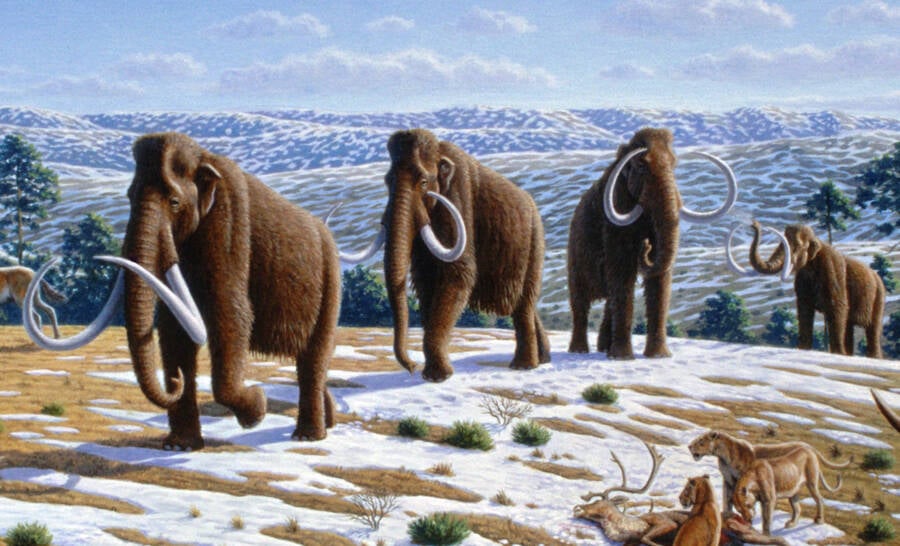By analyzing DNA found in Canadian soil samples from thousands of years ago, scientists have adjusted the timeline of the woolly mammoths’ extinction by 8,000 years.

Wikimedia CommonsAnimals like the woolly mammoth left trace amounts of DNA in frozen soil.
When did the woolly mammoth go extinct? Scientists have long believed that woolly mammoths died out some 13,000 years ago. But a new study suggests that they survived much longer.
In a study published in Nature, researchers from McMaster University, the University of Alberta, the American Museum of Natural History, and the Yukon government combed through ancient soil samples for clues about the mammoth’s decline.
They found that woolly mammoths — along with steppe bison and Ice Age horses — had survived 8,000 years longer than previously thought. All three species endured even as the climate warmed and human hunters became an ever-present threat.
“We… identify a lingering signal of Equus sp. (North American horse) and Mammuthus primigenius (woolly mammoth) at multiple sites persisting thousands of years after their supposed extinction from the fossil record,” the researchers explained in their study.
When Did The Woolly Mammoth Go Extinct?
By examining soil samples from the Pleistocene-Holocene transition era, roughly 11,000 to 14,000 years ago, scientists found that mammoth populations were in decline, but the animal hadn’t yet died out.
DNA suggests that they managed to survive until about 5,000 years ago — concurrent with the construction of the Pyramids of Giza.
Incredibly, the scientists made their mammoth find all within a tiny sample of ancient soil. Researchers at McMaster University have been developing a way to extract DNA from soil samples, which is how McMaster University archeologist and the study’s lead author, Tyler Murchie, made the discovery.
“All of the DNA from those animals and plants is bound up in a tiny speck of dirt,” Murchie explained.
“Organisms are constantly shedding cells throughout their lives. Humans, for example, shed some half a billion skin cells every day,” he continued.
“Much of this genetic material is quickly degraded, but some small fraction is safeguarded for millennia through sedimentary mineral-binding and is out there waiting for us to recover and study it.”
Changing The Dates Of Ice Age Extinctions
Remarkably, this revolutionary sample of dirt had gone unnoticed for a decade. It had first been collected in Yukon Territory in 2010 but had been left unanalyzed in a university freezer ever since. Murchie found it in cold storage while searching for inspiration.

Emil Karpinski/McMaster UniversityTyler Murchie studied trace amounts of DNA in ancient soil samples to make the discovery.
“I found them in the freezers while looking for a new project during my PhD,” Murchie said.
“One of my responsibilities at the ancient DNA center is freezer maintenance, so I had a good idea of what cool stuff might be in there waiting for someone to study.”
By examining the soil sample, he and his team could paint a picture of the ecosystem dating back to 30,000 years.
“Just from gathering tiny flecks of dirt — in this case between about 0.5 and 1 gram, which is very little sediment — we can reconstruct the whole ecosystem with a variety of animals that existed in the area,” Murchie explained.
The permafrost, he added, helps preserve DNA over thousands of years by keeping it cold and protected from elements like water and sunlight. “They’re just kind of locked in place until someone comes along and is able to recover those fragments,” he said.
What’s more, Murchie added, his discovery demonstrates the incredible potential of soil samples trapped by permafrost.
“Now that we have these technologies, we realize how much life-history information is stored in permafrost,” he said.
“The amount of genetic data in permafrost is quite enormous and really allows for a scale of ecosystem and evolutionary reconstruction that is unparalleled with other methods to date.”
But these windows into ancient life on earth are rapidly narrowing. Permafrost across the globe is melting as the climate warms, destroying evolutionary evidence about earth’s history.
“If we don’t collect the samples, and they just thaw and degrade, then we lose all that life history data that’s been preserved for all this time,” Murchie said.
Still, the melting permafrost has offered up other ancient secrets. In recent years, researchers have found an incredibly well-preserved Ice Age bear in the Siberian permafrost and a mummified 18,000 year old puppy.
As such, it’s sure that permafrost will continue to offer up new discoveries — even as a warming climate erases some ecological evidence for good.
After learning about when did the woolly mammoth go extinct, learn how one company is trying to revive the woolly mammoth. Or, see how these 28,000-year-old woolly mammoth cells shockingly showed signs of life.





